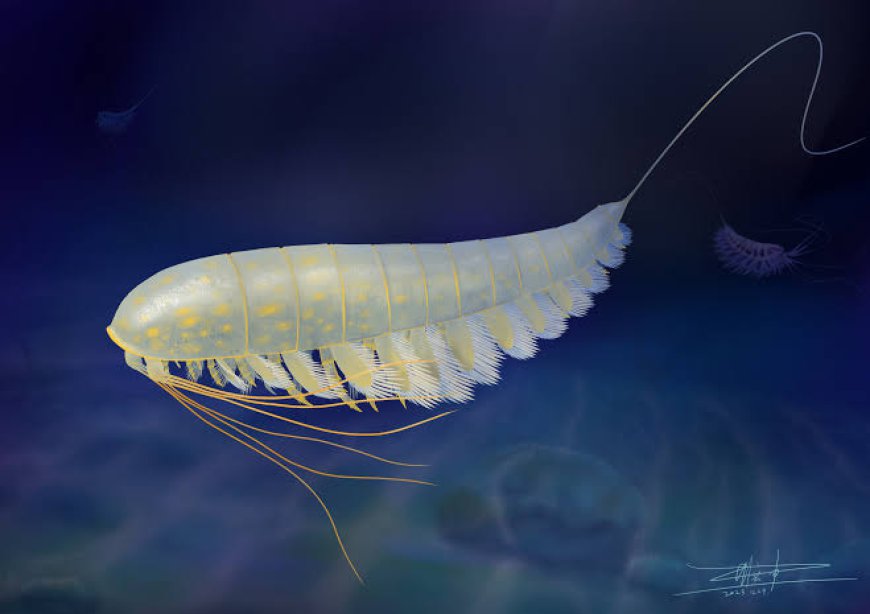A Glimmer of the Past: The 450-Million-Year-Old Arthropod Fossil Preserved in Fool's Gold
In the vast expanse of Earth’s geological history, certain discoveries illuminate the path of evolution, offering tantalizing glimpses into the ancient world. One such remarkable find is the 450-million-year-old fossil of an arthropod, recently uncovered in New York, revealing the fascinating complexities of early life on our planet. This discovery not only sheds light on the characteristics of this ancient organism but also enhances our understanding of the evolutionary lineage of modern arthropods, such as crabs, scorpions, and spiders.

The Discovery of Lomankus edgecombei :-
The fossil, dubbed *Lomankus edgecombei*, was found in a location known as the Edinburg Formation in New York, a site renowned for its well-preserved fossils from the Devonian period. Researchers from the University of the Western Cape and other institutions described this specimen as a member of the extinct group of arthropods, showcasing distinct anatomical features that link it to modern relatives.
The significance of this find lies not only in its age but also in the conditions under which it was preserved. The fossil is encapsulated in pyrite, commonly known as fool's gold due to its metallic luster and pale golden hue. Pyrite has long puzzled scientists due to its ability to preserve organic structures in remarkable detail, a property that has now provided unprecedented insights into the morphology of early arthropods.
Preservation in Pyrite: The Science Behind It -
Fossilization is a rare occurrence; for an organism to become fossilized, it must be buried quickly in sediment and protected from decay. In the case of *Lomankus edgecombei*, the conditions were particularly favorable. The surrounding sediment likely contained minerals that reacted with the organic matter of the organism, resulting in its preservation in pyrite.
The pyritization process begins when sulfate-reducing bacteria metabolize organic material, producing hydrogen sulfide. This gas can then react with iron present in the sediment, forming pyrite. The result is a fossil that retains the fine details of its original structure, including soft tissues, which are often lost in other fossilization processes. This unique preservation method allows paleontologists to study the organism's anatomy with a level of detail that would otherwise be unattainable.
Anatomical Insights: A Window into Evolution :-
The *Lomankus edgecombei* fossil offers a treasure trove of anatomical information. Researchers identified distinct features such as a segmented body, jointed appendages, and specialized structures, which provide critical insights into the evolutionary trajectory of arthropods. The discovery of these traits helps to fill gaps in the fossil record and clarifies the evolutionary relationships between extinct and extant species.
One of the most striking features observed in this fossil is its appendages, which are believed to have played a crucial role in locomotion and feeding. These jointed limbs are indicative of the arthropod body plan, which has proven highly successful over millions of years. The preservation of such features allows scientists to reconstruct the lifestyle and ecological niche of *Lomankus edgecombei*, suggesting that it was likely a predatory organism inhabiting shallow marine environments.
Evolutionary Significance of *Lomankus edgecombei* :-
The evolutionary implications of this discovery are profound. Arthropods are one of the most diverse and successful groups of animals on Earth, with an estimated 80% of all known animal species classified within this phylum. The *Lomankus edgecombei* fossil provides vital clues about the early evolution of arthropods, particularly regarding their transition from marine to terrestrial habitats.
Scientists believe that the lineage leading to modern crustaceans and terrestrial arthropods branched off from early marine forms similar to *Lomankus edgecombei*. This transitional phase is crucial for understanding how life adapted to various environments, leading to the emergence of diverse species that occupy ecological niches today.
Comparative Anatomy: Bridging Past and Present :-
To appreciate the evolutionary significance of *Lomankus edgecombei*, it is essential to compare it with both its ancient relatives and modern arthropods. Early arthropods exhibited a wide range of forms and adaptations, and *Lomankus* fits into this complex picture. For instance, its segmented body and jointed appendages mirror those found in modern crustaceans and insects, highlighting the persistence of these traits over millions of years.
Research on other fossils from the same period reveals a spectrum of body plans and adaptations. For example, another ancient arthropod, *Marrella*, known for its peculiar morphology, provides contrasting insights into the diversity of forms that existed during the Cambrian period. Such comparative studies enable paleontologists to construct a clearer picture of how these ancient organisms relate to one another and how they have influenced the evolution of modern species.
lmplications for Future Research :-
The discovery of *Lomankus edgecombei* opens new avenues for research into the Devonian period, often referred to as the “Age of Fishes.” During this time, the planet underwent significant ecological changes, including the colonization of land by plants and animals. By studying ancient arthropods, scientists can gain insights into the adaptations and evolutionary pressures that shaped life during this critical period.
Additionally, the unique preservation method of pyrite can inspire further investigations into other fossil sites where similar conditions might have existed. By locating and studying additional fossils preserved in pyrite, researchers may uncover more about the early evolution of arthropods and the ecological dynamics of ancient ecosystems.
The Role of Technology in Fossil Analysis :-
Modern technology plays a vital role in the analysis of fossils like *Lomankus edgecombei*. Advanced imaging techniques such as X-ray computed tomography (CT) and scanning electron microscopy (SEM) allow scientists to visualize the internal structures of fossils without damaging them. These techniques have revolutionized paleontology, enabling detailed examinations of anatomy and the identification of previously undetectable features.
For example, using CT scans, researchers can create 3D models of fossils, revealing intricate details about their morphology. Such models provide invaluable data for understanding how these organisms lived, moved, and interacted with their environment. As technology continues to evolve, it will undoubtedly enhance our ability to study ancient life and the processes that shaped our planet's biodiversity.
A Broader Perspective: Fossils and the Tree of Life :-
The study of fossils like *Lomankus edgecombei* plays a crucial role in constructing the tree of life, which represents the evolutionary relationships among all living organisms. Fossils serve as vital records of past life, enabling scientists to trace the lineage of species and understand the processes that led to their diversification.
This discovery not only enriches our knowledge of arthropod evolution but also emphasizes the interconnectedness of life on Earth. Each fossil unearthed adds another branch to the tree of life, revealing the intricate web of relationships that bind all organisms together.
Moreover, understanding the evolutionary history of arthropods can provide insights into the future of biodiversity. As species continue to adapt to changing environments, studying the evolutionary responses of ancient organisms can help predict how modern species may cope with climate change and habitat loss.
Educational and Cultural Impacts :-
The discovery of *Lomankus edgecombei* extends beyond the scientific community, having implications for education and public engagement with paleontology. Fossils serve as tangible connections to our planet's history, igniting curiosity and interest in the sciences among students and the general public.
Museums often showcase such discoveries, providing educational opportunities and fostering a greater appreciation for the natural world. Engaging displays, interactive exhibits, and educational programs can inspire future generations to pursue careers in science and conservation, promoting awareness of biodiversity and the importance of preserving our planet's heritage.
The Legacy of *Lomankus edgecombei* :-
The unearthing of *Lomankus edgecombei* in New York serves as a reminder of the intricate tapestry of life that has unfolded over millions of years. This 450-million-year-old fossil, preserved in pyrite, offers a unique glimpse into the distant past, showcasing the complexity and adaptability of early arthropods. As researchers continue to study this remarkable specimen, they uncover not only the history of a single organism but also the broader narrative of life’s evolution on Earth.
In a world where ancient secrets lie beneath our feet, each fossil discovery fuels our curiosity and deepens our appreciation for the extraordinary journey of life. The legacy of *Lomankus edgecombei* will undoubtedly inspire future generations of scientists and enthusiasts alike, encouraging them to explore the depths of our planet’s history and the wonders it holds.
Conclusion: Embracing the Mysteries of the Past -
As we reflect on the significance of *Lomankus edgecombei*, we are reminded that our understanding of evolution is ever-evolving. Each new discovery contributes to a mosaic of knowledge, challenging preconceived notions and inviting us to reconsider the relationships between ancient and modern life. The fossil record, while incomplete, offers profound insights into the journey of life on Earth, illuminating the paths taken by our ancestors.
The story of *Lomankus edgecombei* is a testament to the resilience of life and the enduring quest for knowledge. As we continue to explore our planet and unearth its secrets, we foster a deeper connection to the natural world and a commitment to preserving the biodiversity that has flourished for millions of years. The past may be shrouded in mystery, but with each fossil we uncover, we step closer to understanding the intricate web of life that has shaped our planet and will continue to do so for eons to come.














































